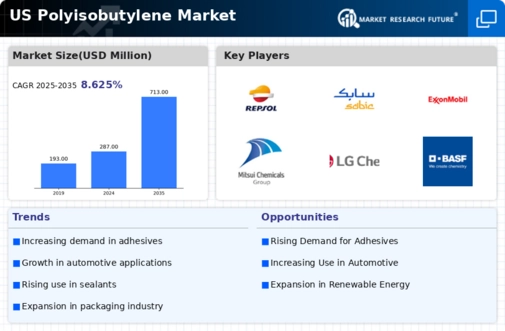The polyisobutylene market exhibits a dynamic competitive landscape characterized by a blend of innovation, strategic partnerships, and regional expansion. Key players such as BASF SE (Germany), ExxonMobil Chemical (US), and Kraton Corporation (US) are actively shaping the market through their distinct operational focuses. BASF SE (Germany) emphasizes sustainability and innovation, investing in eco-friendly production methods, while ExxonMobil Chemical (US) leverages its extensive supply chain to enhance operational efficiency. Kraton Corporation (US) is focusing on product diversification and technological advancements, which collectively contribute to a competitive environment that is increasingly driven by sustainability and innovation.
The business tactics employed by these companies include localizing manufacturing and optimizing supply chains to enhance responsiveness to market demands. The competitive structure of the polyisobutylene market appears moderately fragmented, with several key players exerting influence. This fragmentation allows for a variety of strategies to coexist, fostering an environment where innovation and operational excellence are paramount.
In October 2025, BASF SE (Germany) announced a partnership with a leading renewable energy firm to develop bio-based polyisobutylene products. This strategic move underscores BASF's commitment to sustainability and positions the company to capture a growing segment of environmentally conscious consumers. The collaboration is expected to enhance BASF's product portfolio while aligning with global trends towards greener alternatives.
In September 2025, ExxonMobil Chemical (US) unveiled a new manufacturing facility in Texas aimed at increasing production capacity for polyisobutylene. This expansion is significant as it not only bolsters ExxonMobil's market presence but also enhances its ability to meet rising demand in various applications, including automotive and adhesives. The facility is expected to utilize advanced technologies, further solidifying ExxonMobil's competitive edge in the market.
In August 2025, Kraton Corporation (US) launched a new line of high-performance polyisobutylene products tailored for the automotive sector. This introduction reflects Kraton's strategic focus on innovation and product differentiation, allowing the company to cater to specific industry needs. The launch is anticipated to strengthen Kraton's market position and drive revenue growth in a competitive landscape.
As of November 2025, the competitive trends in the polyisobutylene market are increasingly defined by digitalization, sustainability, and the integration of advanced technologies such as AI. Strategic alliances are becoming more prevalent, enabling companies to leverage complementary strengths and enhance their market offerings. Looking ahead, competitive differentiation is likely to evolve from traditional price-based competition towards a focus on innovation, technological advancements, and supply chain reliability, as companies strive to meet the demands of a rapidly changing market.


















Leave a Comment